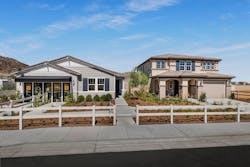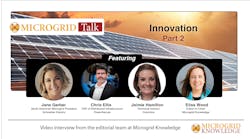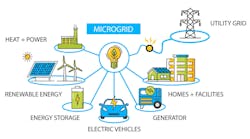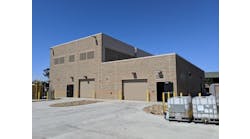After years of making little progress, community microgrids are rapidly innovating with the most recent example – a nested community microgrid – unveiled this week in Menifee, California.
Buyers have already contracted for 58 of the roughly 200 homes to be built in two KB Home neighborhoods. Each home has its own nanogrid that is connected to a central microgrid. The central microgrid connects the two neighborhoods for energy sharing.
What is a nested community microgrid?
Still rare, a nested microgrid connects several separate distributed energy resources or microgrids that are on the same utility circuit. They are akin to shared microgrids or microgrid clusters. Some view these advanced connections as the future direction for the electric grid because of the level of electric reliability they afford. They see an eventual grid of connected microgrids.
Nested microgrids also offer the opportunity for highly efficient use of energy resources, as John Westerman, director of project development and engineering at Schneider Electric, explained in an interview with Microgrid Knowledge yesterday.
Schneider is providing KB Home's with the controller and home energy management technology and is part of a group of companies and organizations working on the project with the help of a $6.6 million federal grant. In addition to Schneider and KB Home, the partners are SunPower, a home solar and energy storage company; the US Department of Energy; the Advanced Power and Energy Program at the University of California, Irvine; local utility Southern California Edison (SCE); and car manufacturer Kia.
Complex orchestration
The system demonstrates a complex orchestration provided by a series of microgrid controllers and switching stations operating between the homes, microgrid and SCE.
Each home will have its own solar panels and a battery. If the home produces excess energy, it can feed it into the microgrid. When a power outage occurs, the home will first rely on its own battery for power, Westerman said. If that depletes, the power kicks in from the central microgrid, which will have islanded from SCE’s system. The microgrid reconnects when the grid is operating normally; it is then able to sell services to the grid as a means to produce revenue.
Schneider’s home energy management technology is also installed in each home. Among other things, it allows energy loads to be prioritized during a power outage, meaning energy goes to only certain appliances so that the battery power isn’t used up too quickly.
For first-time home buyers
KB Home decided to tackle the project as part of its ongoing effort to find ways to reduce energy costs in homes designed for first-time homebuyers in California. The homes are being offered for $490,000-$590,000, which is a competitive price in the inflated California housing market, said Dan Bridleman, KB Home senior vice president of sustainability, technology and strategic sourcing, in an interview.
“And you get the incremental benefit of having the ability to have the microgrid and a battery and a community battery and all the technology that comes with it,” he said.
In addition to the microgrid services, the all-electric homes include energy efficiency measures, energy monitoring and wiring for electric vehicle (EV) charging. Ten of the homes will test bidirectional EV chargers designed to make EVs another source of energy during a power outage.
KB Home has built more than 160,000 Energy Star certified homes since 2000 and now sees resilience as “the next frontier for communities,” Bridleman said. The community microgrid makes increasing financial sense, he said, as batteries become more affordable.
The company has the advantage of building new communities, which makes the energy installation and wiring easier than it would be in an existing neighborhood, he added.
About 48 of the homes are now in construction, and KB Home expects the first one to be finished in the first quarter of next year.
Other innovative microgrid communities
The KB Home project follows other recent neighborhood microgrid innovations. In Tampa, Florida, Emera Technologies is using what it calls BlockEnergy to create a community microgrid that offers home nanogrids. Like the KB Home project, its microgrid connects to the utility grid. Meanwhile, residential solar company Sunnova is proposing a different concept that would have each community form its own microutility to operate its microgrid.
Meanwhile, the microgrid industry is slowly testing the concept of clustered microgrids, with the most cited project located in the Bronzeville area of Chicago, where Commonwealth Edison and the Illinois Institute of Technology are connecting two microgrids.







